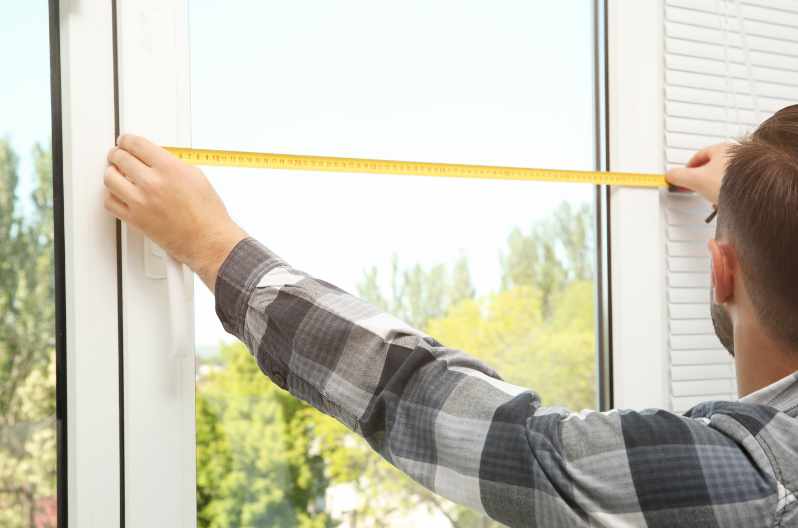
How To Measure for Replacement Windows
The key to long-last, energy-efficient windows is getting the right fit. And that means accurate measurements and quality manufacturing. While you can measure for replacement windows yourself, most installers will take their own to ensure every window fits precisely. Here are the basics of how to measure for window replacement.
5 Tips for Getting Precise Measurements for Replacement Windows
1. Clearly Record the Size of All Windows
Before you pull out your tape measure, you need to make sure you clearly record measurements for each window in your house. Even if windows look the same size, measure each one separately.
Also, clearly label each window based on the room it’s in and what wall it’s on. Great examples of window names include “Mary’s bedroom, blue wall, driveway side,” “Devon’s office, rear exterior wall,” and “master bath, shower vent.”
Another alternative is to number each window. Write a number on a piece of tape and stick it to the glass, so there is absolutely no confusion. If you want to get excessive, consider sketching out each window or even including a photo of the window with the measurements.
2. Make Sure the Frames Are Square
Checking for square means making sure every corner is at a 90° angle. If the frame isn’t square, it can put unnecessary stress on your new windows. This will reduce how long they last or even impact noise reduction and energy savings. In rare cases, they might not even open.
To make sure it is square, start in the top right corner and measure diagonally across the window to the bottom left. Then repeat the process from the top left corner to the bottom right.
While it’s unlikely that both measurements will be identical, they should be within a quarter inch of each other. As long as they are, you proceed with measuring your windows. If they are not square, you will need to have the frame rebuilt first. Any window installation company can take care of this, but it will add to the total cost.
While you can keep measuring if your windows are not square, you can save time in the long run by calling a local contractor. They can double-check your measurements and assess how to proceed with replacing your windows.
3. Measure the Width, Height, and Depth
Next, you need to measure every window’s width, height, and depth. Starting with the window’s width, measure at the top, middle, and bottom. Hold the tape measure against the window jamb and pull it taut for an accurate measurement.
You will also take three measurements for the window’s height as well. Measure the left, middle, and right, keeping the tape measure as taut as possible. Write down all three measurements for both width and height.
To measure the window depth, open it up and make sure it is at least three and quarter inches deep. While the window depth isn’t used during manufacturing, you need to ensure that new windows will fit the existing frames.
With all of your measurements, only measure the window itself. Do not include the wall, trim, or any other part of the window area. If you are unsure what to measure, call a window installer. They can properly measure your windows for you.
4. Always Measure Twice
Precise measurements are critical to getting the right size windows, so measure everything twice. While you can do this as you go, it’s best to measure each window once before going through your house again.
While you can take the measurements one after the other, it’s easier to assume you are right and write down the wrong dimensions. By measuring all your windows one time and then repeating the process again, you are less to make a mistake.
Another way to limit mistakes is to measure them on different days. Measuring is easy but time-consuming. Breaking it over two or more days makes it easy to get the right measurements each time.
Regardless of how and when you take your measurements, make sure all of the numbers match perfectly. If you get different results, remeasure that window entirely until you have consistent measurements.
5. Round Your Measurements Down
Once you have measured every window twice, choose the lowest width and height for each window and round down to the nearest eighth of an inch. So if the width is 28 7/16 inches, round down to 28 3/8.
There is no need to round if it already measures in eights. The same is true if the measurement is in quarters or is perfectly one-half inch.
If precise measurements matter, why round them down? It does seem crazy, but it has to do with manufacturing. While most windows are made to order, they come in standard sizes.
This allows manufacturers to keep costs low while still making windows that fit properly. Plus, rounding to the nearest eighth of an inch is such a small change that it won’t impact the window fit or performance.

Why Measure Your Windows Yourself?
Since every window company will do it for you, why bother measuring your windows yourself? Sure, it takes a few hours, but it’s a great way to get a good picture of how much new windows will cost.
The size of the window is one of the biggest factors in the total cost. When you are talking to a window company, you already know the number of windows and the basic sizes. This makes estimating easier and allows you to focus more on getting the right features for your windows.
For example, you might want to upgrade to triple-pane windows along the street to reduce road noise. Whereas you can use standard double-pane windows for windows on the sides and back to save a little money. Knowing the sizes makes it easier to compare those prices and make the right decisions.
While you can also order the windows and install them yourself, it takes a fair amount of skill. Not to mention the right tools and equipment. However, it’s definitely another reason to measure your windows yourself. Just make sure you weigh all of the pros and cons before replacing your own windows.
